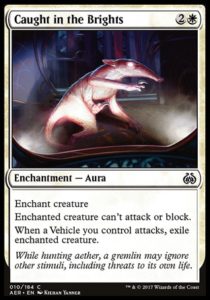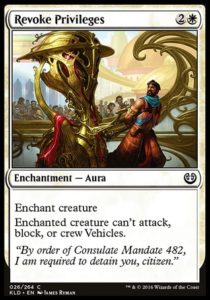Pacifism and Arrest effects have consistently ranked among the best common removal spells in Magic. Pacifism (or a modified equivalent) is routinely white’s best common. This is hardly surprising, since the ability to (effectively) kill any creature for a small-to-moderate cost is exactly what every player wants. Pacifism effects tend to be nigh-impossible to answer, since enchantment removal is almost never maindeckable (unless you’re on Theros) and sets tend to be light on sacrifice outlets and gating (returning permanents to your hand as a cost), which punish enchantment-based removal.
Ixalan has given us Pious Interdiction, the newest Pacifism (and a weaker version of Faith’s Fetters, an incredibly powerful removal spell). How does it stack up to the competition?

Past-ifisms
To properly evaluate Pious Interdiction, we need to not only examine Ixalan Limited, which is still very new. We also need to evaluate what came before.
In the past year, Caught in the Brights and Compulsory Rest have been strong, but lackluster removal spells. Caught in the Brights couldn’t answer vehicles or activated abilities (which Kaladesh was full of) and was in white, the weakest color. Compulsory Rest was just a worse play than Gust Walker and couldn’t effectively stop a lot of synergies (like Embalm and Eternalize). These cards are still quite strong, but if you go back a few years, these cards would have been amazing. What gives?

Arrested in Time
Magic is a fluid game and has seen several trends over the last few years:
- Creatures have gotten a lot stronger. There are increasingly many two and three-drop creatures which demand answers, so removal needs to be used more often and for less mana advantage.
- Sets tend to have aggressive mechanics which encourage attacking and make blocking worse. Ixalan has Raid. Amonkhet has Exert. Kaladesh has energy creatures like Thriving Rhino and vehicles like Renegade Freighter. This taxes removal spells since your creatures are less able to efficiently answer your opponent’s creatures.
- Removal has gotten weaker, either by having more restrictions or by costing more. This is most pronounced at common, where removal used to be grossly overpowered.
All of these factors make removal worse. The ability to answer your opponent’s creatures is still deeply valuable, but it’s tempered by just how many creatures might demand an answer before you see the one threat you need removal for.

How is it?
Pious Interdiction is telling of just how good Pacifism is. Pious Interdiction appears nuts—it’s a splashable, unconditional removal spell with incidental life gain, all for the same as an Oblivion Strike. It’s certainly a downgrade to Pacifism, but that’s more a commentary on how bonkers Pacifism is than how lacklaster Pious Interdiction is.
Pious Interdiction looks to exist in a much friendlier format than Compulsory Rest or Revoke Privileges did. There aren’t any common vehicles, there isn’t a crazy powerful aggro mechanic like Exert, and there aren’t a ton of powerful activated, sacrifice, or gating abilities. Many decks are encouraged to go tall on a single creature, like merfolk putting +1/+1 counters on a creature, decks relying on powerful auras like One With the Wind, or decks investing lots of mana into an expensive dinosaur. There’s even a mechanic in treasure that encourages/enables players to play greedy big-mana, multicolor decks in which Pious Interdiction will shine.
So, even though Pacifisms have been getting weaker, and even though Pious Interdiction is a much weaker Pacifism, many signs point to it being a top-tier removal spell and common.
The skies be not calm just yet
Nevertheless, I’m not ready to call Pious Interdiction one of the hands-down best commons without playing more Ixalan. Every tribe has the ability to go wide, the strategy that most heavily taxes one-for-one removal and most punishes mid and high-cost kill spells. Moreover, every color has a playable two drop (red has four at common), which increases the likelihood of early pressure and Pious Interdiction trading down on mana and for a non-bomb creatures. Explore creatures further weaken the value of one-for-one removal by providing additional value.
I’ve been impressed by Pious Interdiction thus far and definitely want to open it in Sealed. But we have yet see just how fast the Limited format is, how deep white is, how friendly the format is to greed, and how unstoppable its bombs are. It’s always worth considering how each format changes card evaluations and how variations on a very familiar theme can vary drastically based on context. Pious Interdiction has all the hallmarks of being a great common removal spell (and likely is), but we become better players, thinkers, and designers when we don’t rely solely on past experience to understand the present.
And, as always, thanks for reading.
—Zachary Barash
Zachary Barash is a New York City-based game designer. He works for Kingdom Death: Monster, has an MFA in Game Design from NYU, and does freelance game design.
His favorite card of the month is Moment of Heroism. This unassuming little pump spell looks lackluster (after all, we get +2/+2 combat tricks with upside for W these days), but it can lead to complete blowouts in combat, where you kill a creature and gain 3-5 life for only two mana. It was particularly good in Innistrad, where instant-speed removal was weak and the (second) best deck in the format was an aggro deck overloaded on two drops. Sometimes, you just cast it to gain 5 life and flip the race on your opponent. It’s a delightfully simple card that beginners can understand, but it has powerful enough upside that skilled players can seek to maximize its effectiveness (while also siding it out when it’s irrelevant). That’s a whole lot to pack into a common combat trick with only two lines of text.


